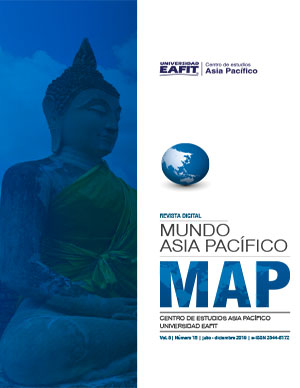Devouring the Hallyu: Development, Hybridization, and Latin American Cannibalism
Main Article Content
Keywords
Hallyu, Culture, Korea, Anthropophagy,, Latin America
Abstract
This article presents a brief history of the Korean wave or Hallyu, its generations and physiognomy. It also analyses the growth of this phenomenon in Asia and Latin America based on the parallelism between the assimilation of technologies, Western modes of representation in the Korean creative industry, and the design of public policies by the Korean State. Finally, the hybrid character of the Hallyu will be discussed as well as the totalizing character of the label "Korean culture", and also the need to approach this manifestation from a cultural construct specific to Latin America; for this, the cultural anthropophagy proposal is used.
Downloads
References
Baitello Junior, N. (2004). Las cuatro devoraciones. Iconofagia y antropofagia en la comunicación y la cultura. Revista Internacional de Comunicación Audiovisual, Publicidad y Literatura, 1 (2), 159-168. Recuperado de: https://idus.us.es/xmlui/bitstream/handle/11441/57556/las_cuatro_devoraciones_ iconofagia_y_antropofagia_en_la_comunicacion_y_la_cultura.pdf?sequence=1&isAllowed=y
Berg, S. (2015). Creative Cluster Evolution: The Case of the Film and TV Industries in Seoul, South Korea. European Planning Studies, 23(10), 1993–2008. Recuperado de: https://doi.org/10.1080/09654313.201 4.946645
Bodomo, A., & Chabal, E. S. (2014). Africa-Asia relations through the prism of television drama: How Africans in Hong Kong Conceptualize Korean Culture. African and Asian Studies, 13(4), 504–529. Recuperado de: https://doi.org/10.1163/15692108-12341319
Cámara, M. (2013) Utopía y barbarie, la operación aqntropofágica de Oswald de Andrade. Ipotesi, 17; 1; 7-2013; 17-27. Recuperado de: http://hdl.handle.net/11336/3790
Che-gyu, K. (2011). Planet Hallyuwood: Imaging the korean war, 14(1), 197–212.
Finchum-Sung, H. (2009). Image is everything: re-imaging traditional music in the era of the Korean wave. Southeast Review of Asian Studies, 31(1), 39–55.
García Canclini, N. (2003). Noticias recientes sobre la hibridación. Trans. Revista Transcultural de Música, 7, 1–17. Recuperado de: https://www.redalyc.org/pdf/822/82200702.pdf
García Canclini, N. (5 de 12 de 1999). Gourmets multiculturales. Recuperado de La Jornada Semanal: https://www.jornada.com.mx/1999/12/05/sem-nestor.html
Hogarth, H. K. K. (2013). The Korean wave: An Asian reaction to western-dominated globalization. Perspectives on Global Development and Technology, 12(1–2), 135–151. Recuperado de: https://doi. org/10.1163/15691497-12341247
Huh, C. G., & Wu, J. (2017). Do Hallyu (Korean Wave) Exports Promote Korea’s Consumer Goods Exports? Emerging Markets Finance and Trade, 53(6), 1388–1404. Recuperado de: https://doi.org/10.1080/15404 96X.2017.1313161
Hwy-Chang, M., & Parc, J. (2013). Korean dramas and films: Key factors for their international competitiveness. Asian Journal of Social Science, 41(2), 126–149. Recuperado de: https://doi. org/10.1163/15685314-12341295
Iadevito, P., & Bavoleo, B. (2015). Korean soap operas in Latin America a cultural studies approach. Revista Digital Mundo Asia Pacífico, 4(6), 25–39. Recuperado de: https://doi.org/10.17230/map.v4.i6.02
Ko, N., Kim, J.-N., No, S., & Gobbi, R. (2014). The Korean Wave Hallyu in Looking at Escapism in Peruvian Society. Perspectives on Global Development and Technology, 13, 332–346. Recuperado de: https://doi. org/10.1163/15691497-12341305
Lopez Rocha, N. (2015). El rol del Hallyu como cultura pop en la creación y la difusión de la imagen de la mujer coreana contemporánea. http://www.portesasiapacifico.com.mx/?P=articulo&id=307, 9(18), 171–196. Recuperado de: http://dspace.uan.mx:8080/xmlui/handle/123456789/186
Martínez D. (2005) Antropofagia: Hábito y ritual en América Latina Cultural. AISTHESIS N° 38.251-265. Recuperado de: http://revistaaisthesis.uc.cl/index.php/rait/article/view/512/481
Nitschack, H. (2016). Antropofagia cultural y tecnología. UNIVERSUM, 31(2), 157–171. Recuperado de: https://scielo.conicyt.cl/pdf/universum/v31n2/art_10.pdf
Posada Suárez, C. (2013). De reino ermitaño a tigre asiático. El modelo de desarrollo de Corea del Sur. Revista Digital Mundo Asia Pacífico, 2(3), 6–14. Recuperado de: http://publicaciones.eafit.edu.co/index. php/map/article/view/2210/2126
Retondar, A. (2008). Hibridismo cultural: ¿clave analítica para la comprensión de la modernización latinoamericana? La perspectiva de Néstor García Canclini 1. Sociología (Méx), 23(67), 33–49. Recuperado de: http://www.scielo.org.mx/pdf/soc/v23n67/v23n67a3.pdf
Roknik, S. (2011). antropofagia zombie. En VV.AA., Umbrales. Fugas de la institución total: entre captura y vida (págs. 1-25). Sevilla: Universidad Internacional de Andalucía. Recuperado de: http://ayp.unia.es/dmdocuments/umbrales21.pdf
Ryzhkov, A. (2014). TRENDS FOR INTERNATIONALIZATION OF KOREA: From K-POP to K-LAW. In XIV Seminario Internacional de investigación sobre la Cuenca del Pacífico (p. 11). Recuperado de: https://doi. org/10.13140/RG.2.1.2254.1201
Ryzhkov, A., & López Rocha, N. (2017). Hallyu y su percepción por los jóvenes coreanos en el contexto de la marca país coreana. Revista Digital Mundo Asia Pacífico, 6, 11, 6–26. Recuperado de: doi: 10.17230/map.doi v6.i11.01
Schulze, M. (2013). Korea vs. K-Dramaland: The Culturalization of K-Dramas by International Fans. Acta Koreana, 16(2), 367–397. Recuperado de: https://doi.org/10.18399/acta.2013.16.2.004
Se-Woong, K. (29 de 8 de 2014). Korean Exposé. Obtenido de A Brief Note on the History of Korean Cannibalism. Recuperado de: https://www.koreaexpose.com/why-south-koreans-crave-human-flesh/
Shim, D. (2011). Whither the Korean Film Industry? Acta Koreana, 14(1), 213–227.
Smith, P. B. (2011). Cross-Cultural Perspectives on Identity. In S. J. S. et Al (Ed.), Handbook ofIdentity Theory and Research (pp. 249–265). Sussex: Springer Science+Business Media. Recuperado de: https://doi.org/10.1007/978-1-4419-7988-9_11
Sung, S. Y. (2010). Constructing a new image. Hallyu in Taiwan. European Journal of East Asian Studies, 9(1), 25–45. Recuperado de: https://doi.org/10.1163/156805810X517652
Valadez, C. A. (2016). Conceptualización de un segmento de mercado particular identificado con el
K-pop en México. Portes, Revista Mexicana de Estudios Sobre La Cuenca Del Pacífico, 10(20), 181–201. Recuperado de: http://search.ebscohost.com/login.aspx?direct=true&db=a9h&AN=120376094&lang= es&site=ehost-live
Yoon, S. (2015). Taming the Primitive: Multiculturalism and the Anthropological Vision of South Korean Media. Visual Anthropology, 28(5), 422–437. Recuperado de: https://doi.org/10.1080/08949468.2015.1086209

